Today I’m going to write about slide rule on watch bezel. I’m sure you guys who are aviation watch fans will notice that some of those watches have 2 scales on the watch, one on the bezel and one on the dial.
A Seiko Flightmaster SNA411 with rotary slide rule on it. Notice the two small scales on the bezel (a bi-directional rotating bezel) and on the edge of the black dial. These two scales make up the slide rule.
Well guys, those are the slide rule (or rotary slide rule since it’s a circular rule now). But what actually is slide rule? Who invented this thing? How to use slide rule on watch?
Don’t worry guys, I’ll answer these questions in this article. Let’s take a look at what is slide rule first.
What Is Slide Rule?
If you have been born prior to calculator invention, then you might have been fortunate to use a slide rule during school or work. But I bet most of you guys don’t know what it is.
What is a slide rule?
Slide rule is a nifty tool invented hundreds of years ago to help its users to quickly do many complicated calculations such as:
- Multiplication
- Division
- Square root
- Exponential
- Logarithms
- Trigonometric functions

A typical slide rule which was widely used before the invention of cheap handheld calculators
As you can see, there is no addition or subtraction in the list since those are very easy to be calculated manually on a piece of paper or just inside our head (I can’t really do this but I’ve know a few gifted people who can!).
By using slide rule, these more complicated calculations can be done quickly without resorting to tedious manual calculations which has lots of room for erros. In short, slide rule is the ancient calculator before the calculator as we know now!
History Of Slide Rule
An English mathematician, Reverend William Oughtred was widely credited for the invention of slide rule in the 1630.
He used the prior inventions of logarithm and logarithm scales by John Napier and Edmund Gunter respectively a few decades ago to create the slide rule, becoming the first person to use two scales of logarithm, one sliding on the other, to perform multiplication and division directly.

Reverend William Oughtred, the first person who invented slide rule in 1630
This invention was then widely used in lots of professions that require complex calculations such as engineers, astronomers, scientists and such.
Having such a great tool at the time when all calculations had to be done manually was like a dream come true for them.
As much as Karl Benz revolutionized the world with his car, so does the slide rule to how mathematicians and scientists do their work.
Slide rule was very popular until the mighty computer came….
And Then Comes Electronic Calculator
The advent of computer mark the decline of slide rule. As first, big old computers were invented that can do everything slide rules can do but with more precise calculations.
Since those machines were bulky and expensive, slide rule was still the preferred choice since not everyone can afford these computers.

The invention of cheap, easy to use handheld scientific calculator marked the death of slide rule. How can it possibly compete against such an accurate machine?
But then the computer became smaller and cheaper. Around 1970s, handheld electronic calculators can be had for less than $50 and this marked the end of slide rule’s usage.
How good is electronic calculator compared to slide rule?
By a lot! An electronic calculator can do more calculations than a slide rule. It also can perform additions and subtractions, two basic calculations that slide rule does not have.
And the best advantage is calculators can give out more accurate results that is impossible to get from a slide rule.
This is very important for scientists that require perfect and accurate calculations in their work.
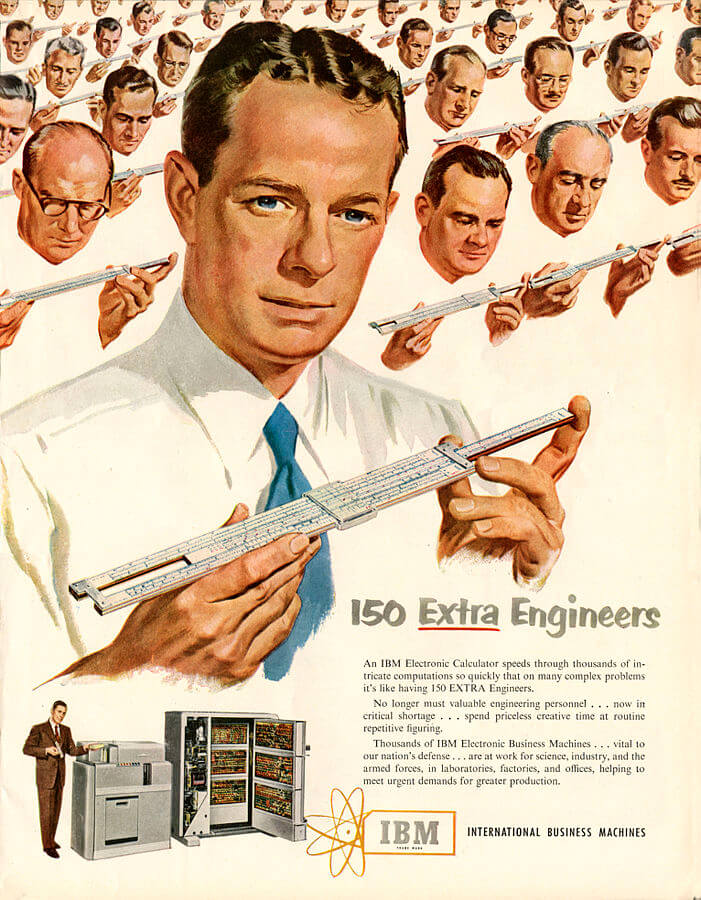
A promotional poster by IBM on how their computer can help with calculations, so much so one computer can do the job of 150 engineers. How true is this!
Just with a small piece of machine, most of the calculations can be performed. It is no wonder that slide rule was kicked out by this very convenient tool.
Rotary Slide Rule On Aviation Watch
I’m not really sure who put the slide rule on a watch bezel but there are sources which states that Breitling is the first watchmaker that put slide rule on a watch back in 1952.
But the slide rule on an aviation watch is not just meant for normal mathematical calculations.
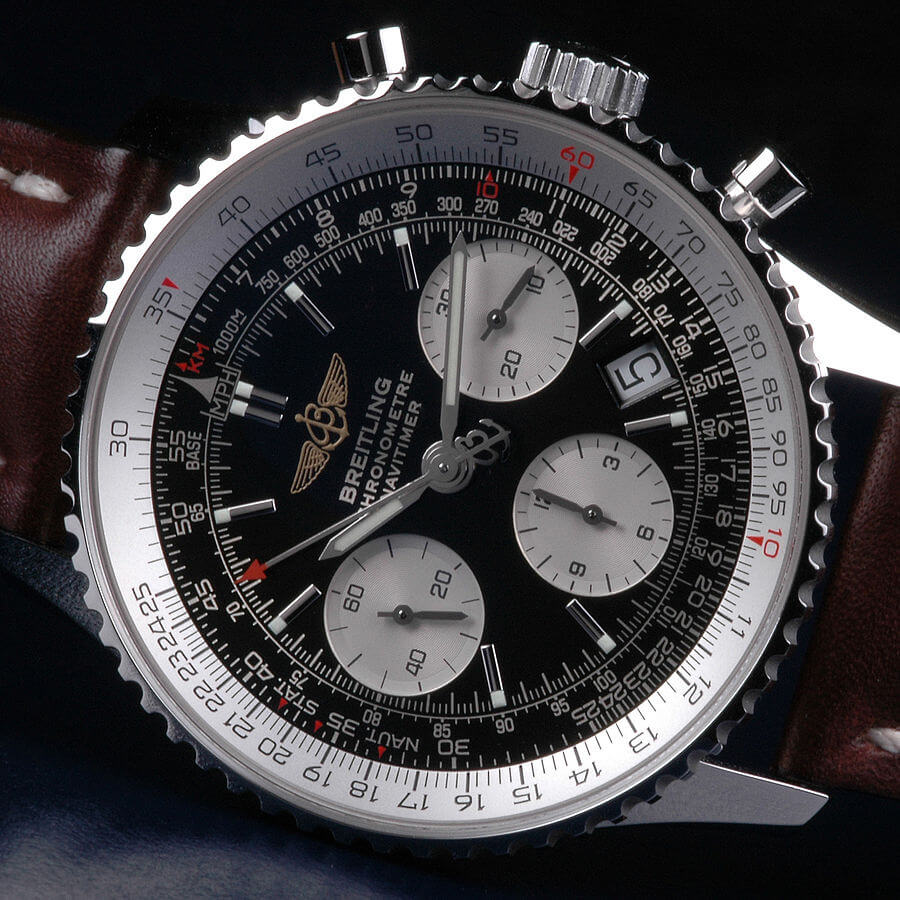
A Brietling Navitimer with Slide Rule on its bezel and edge of dial
In addition to the normal 2 logarithm scales, the rotary slide rule (since it’s not a normal ruler, it’s called rotary by some) is also specially designed for aviation related calculations such as rate of climb/descent, flight time & distance, fuel consumption as well as major unit conversion.
This is easily done by putting more information on the scales and. In the end, this was all for the purpose of making the aviation watch a powerful tool for pilots.
The basic anatomy of a rotary slide rule on a watch is:
1- Inner Logarithm Scale – This scale starts from 10 (or 1 on some watches) until 90 (or 9). The 10 marking usually is placed between 2 to 3 o’clock position so that the 60 marking will sits at the top of the watch (at 12 o’clock).
If you can notice the scale is not linear, that is the distance between each markings become smaller as it increase in value.
Example: distance between 10 to 11 is not the same as 20 to 21. This is logarithm at work here.
2- Outer Logarithm Scale – Same scale as the inner scale, 10 to 90 markings. The difference is the outer scale is usually marked on a bi-directional rotating bezel so that it can be slide.
Some watches do use their outer scale on an inner chapter ring which can be rotated by a dedicated crown (such as the Citizen Blue Angels watch).
Seiko FlightMaster SNA411 not just has a slide rule, but also has tachymeter, unit conversion (for fuel weight, fuel volume, distance), compass ring and minute-hour time conversion. A true tool watch!
3- Other scales – such as tachymeter, distance units conversion (nautical mile, statute mile, km), time conversion and others. This will depend on the watch maker on how busy they want the watch to be.
How To Use Slide Rule On Watch?
So how does one use a slide rule on watch? Well, there are lots of calculations that can be done but I’m going to cover the 4 usages that I feel is the most useful to us.
1- Multiplication
Multiplication is easy it involves one digit. But when it becomes 2 or more digits, things get nasty. Slide rule can be used to do this easily. So suppose you want to find out the product of 55 x 50.
Step I – Bring 55 marking of the outer/bezel scale to the marking 10 of the inner scale.
Step II – Look at the marking 50 on the inner scale
Step III – The product of the multiplication is the marking of the bezel scale inline with 50 on the inner scale
2- Division
Division is harder than multiplication but slide rule will help to make the calculation easier. Suppose we are trying to know the answer to 300/55.
Step I – Move 300 (or 30) on the bezel scale inline with the 55 on the inner scale
Step II – Look at the bezel scale marking inline with the number 10 on the inner scale. The bezel scale marking is the answer.
3- Square Root
Finding the square root for a number is challenging for most people (speaking truthfully here guys lol!). But once again, slide rule can do the job. Unlike the other 2 above, finding square root require trial and error.
Suppose you are finding the square root of 300. ->the answer is 17.3
Step I – Find 300 (or 30) on the inner scale
Step II – Rotate the bezel until the 10 marking is inline with a number (17.3). This number should be the same number on the bezel scale which is inline with the 300 on inner scale.
4- Tipping
By far the easiest one to use and the one we have more possibility of using in daily life a lot. Let’s say we want to give 20% tip on a $30 bill.
Step I – Move the 30 marking on the bezel scale to the 10 marking on inner scale
Step II – Look at the marking 12 on the inner scale. This is because we are adding 20% to the original bill. If we are tipping 30%, then we should check out 13.
Step III – The corresponding number on the bezel scale is the final bill.
There you go guys. It’s very easy and simple. If you want to learn more, you can download this very helpful guide by Seiko on how to use rotary slide rules on a watch (Click HERE to download).
Check out this video on the step by step instructions on how to use slide rule on a watch
CAUTION:
It’s very important for you guys to have a basic understanding of the calculations so that you’ll already have rough idea of the answer. Slide rule can be very confusing, and it’s very easy to get use it wrongly.
Having knowledge on the calculation and a good grasp of numbers (especially the 10s, 100s etc.) will really help to make its usage faster and correct.
A Citizen Blue Angels AT8020-03L with slide rule. The difference with the watch’s slide rule is both scales are located inside the dial, and not on the bezel. So a separate crown (at 8 o’clock) is used to rotate it.
Further Reading:
For those that are very interested in slide rules and how to use them (the actual ruler), you can check out this awesome site which gives huge amount of info on how to use the ruler
->Click Here To Go To SlideRuleMuseum.com<-
For a very cool virtual slide rule, check out this page -> Antiquark.com
Conclusion
Slide rules are the thing in the past and has been replaced by modern calculators. But there is something unique about this device that’s so cool about that.
In my opinion, it’s as cool as automatic watches – both are “antiquated” by today’s technology, but have some very unique characteristics to them.
But still, for work purposes I’d strongly suggest to use calculators to avoid any wrong calculations which can be costly to make =)
**************
Hope you guys have learn a lot about slide rule history and invention. But the most important thing is you guys now know how to use slide rule on a watch bezel. Let me know if you have any questions.
Drop your comments below and subscribe for awesome stuffs in future =)
Cheers!
Isaac

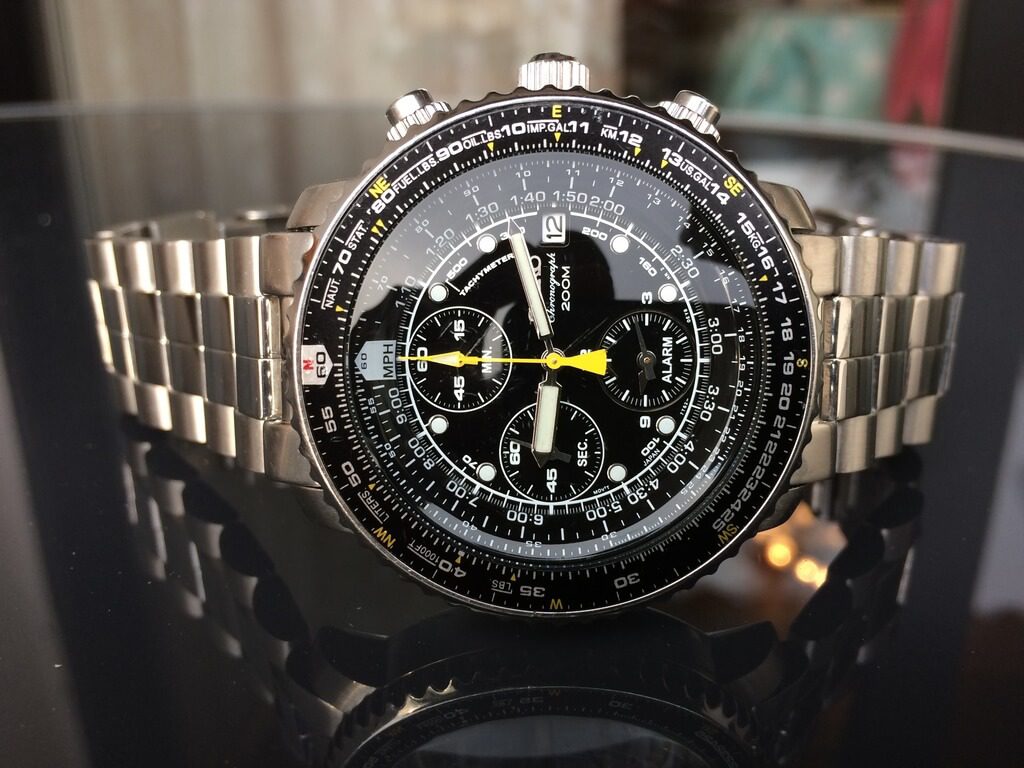
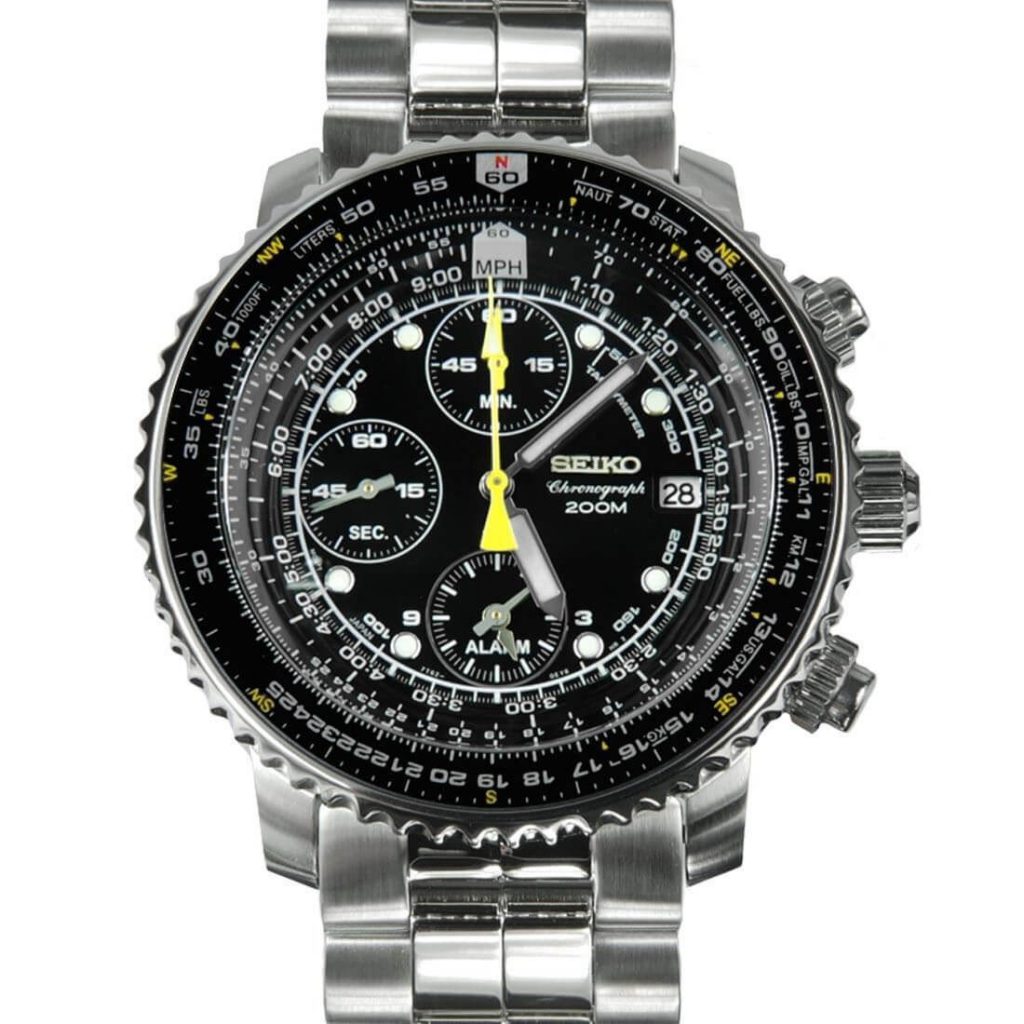
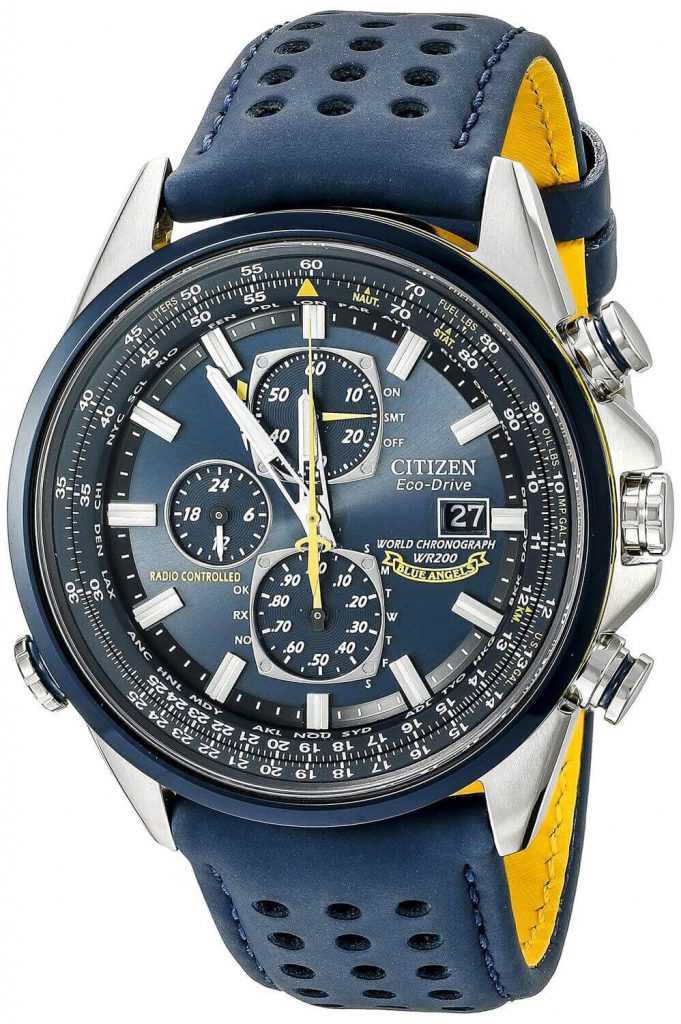
2021, still using my Citizen bezel for quick calculations/conversions. MPH to KM, gallons to liters, kg to lb. My favorite when I travel overseas, is to set the exchange rate, and read as many price conversions I need around the scale. Much quicker than using a calculator each time. For a while I used smart watches, I just got tired to charge them every night or week, so I went back to my Citizen Navihawk A/T. Some things I miss from smart watch, are health monitoring apps, and Apple pay, other than that not to many things are missed. I use Garmin, and Suunto watches when I exercise to get data.
Maybe I am jus an oddball.
This might be bit lengthy about aviation slide rules but bear with me. I’ve been using aviation slide rules most of my 37 year flying career. Aviation slide rules have two sides: A ‘calculator’ side with the log scales (which is what the slide rule on watches replicate) + other conversion/calculation scales in the centre dealing with air pressure & density, Mach Number effects on airspeed measurement; and a ‘wind’ side.
Time/Speed/Fuel/Distance calculations are done using the calculator side, + conversion of fuel volume to mass (Kg/lb USG/Imp Gal/L), general multiplication & division eg calculating weight & balance for loading, equi-time points & points of no return etc.
The wind side is used to solve the ‘navigation triangle’ – a sum of three vector composed of heading & true airspeed, track (or course, in US speak) & groundspeed, & wind direction & speed. Knowing any four then the other two can be found. The most common problem is using known or forecast wind + measured track from A–>B + planned airspeed ==> find the heading required that compensates for the wind blowing you off track, and the groundspeed (speed over the ground is affected by head or tailwind effect).
There are two main types of aviation slide rule due to how the wind side is done: E6B variants which use a rectangular sliding plate through the middle and clear window to draw on and see the markings on the plate, and CR types that replace the slide with a couple of overlaid round rotating plates, the top one see through. The calculator side is much the same on each, although CR types tend to have more scales in the centre for to calculate more things.
Essentially the wind side of E6B ‘slide’ types draw the vectors over the plate, much like drawing the vectors to scale on a sheet of graph paper, and the wind side of CR ’round’ types break up the 3 vector problem into right angle triangles & use trigonometry derive the solution. CR types are more compact, and I think quicker & easier to use, although I’ve used & taught both.
Google E6B flight computer, and Jeppessen CR flight computer and you’ll get a better idea of what I’m trying to describe.
When it comes to slide rule watches I’ve had various ones for decades. I rarely use the slide rule for time/speed/fuel/distance except when I don’t have my normal CR one handy and want to do a quick calc. But when I travel overseas it comes into its own for currency conversions! Set the exchange rate once, and read however many price conversions you like around the scale. So much quicker than using a calculator each time.
Hope this helps.
Interesting stuffs Noel! Thanks for sharing your vast experiences with slide rule watches here. Cheers =)
Apparently this is still used by some and the slide rule on the watches is just a copy of this: https://en.wikipedia.org/wiki/E6B
Cool stuffs Peter! Thanks for sharing. I never thought that pilots would have to do those kind of calculations.. they really make them look cool and laid back in movies lol!
Yes, the slide rule watch bezel is inferior to the breast pocket calculator, but not in speedy checking for gross calc errors.
As an (nowdays 15 years retired) aviator I then used my Citizen bezel to crosscheck the fuel upload gallons vs weight before each flight, and was long done when my young collegae was still strugling with his pocket & calculator. Then we checked our answers. Goody -Go.
Sometimes, the old method can be quicker than the newest ones. Great to hear your story!
Whoa! Ok I had absolutely no idea all of that is going on on my wrist. I just thought all those numbers had something to do either with diving or altitude! My granddad had a Breitling with a slide rule and i used to imagine i was James Bond playing with it. But seriously, tell me, do people actually use this feature or do you think it’s just included for tradition/heritage and prestige?
Frankly speaking, I don’t think people use the slide rule bezel anymore… though I could be wrong! On the other hand, I can see how the bezel can be a great tool for pilots as it’s very easy to do the stuffs with it, such as unit conversions (mile to km, etc.), tachymeter, and others.
But for mathematician, scientists engineers, the slide rule is not a good tool – calculators are way more reliable and accurate.
Cheers!
Is 2021, still using my Citizen bezel for quick calculations/conversions. MPH to KM, gallons to liters, kg to lb. My favorite when I travel overseas, is to set the exchange rate, and read as many price conversions I need around the scale. Much quicker than using a calculator each time. For a while I used smart watches, I just got tired to charge them every night or week, so I went back to my Citizen Navihawk A/T. One thing I miss from smart watch, it is health monitoring apps, and Apple pay, other than that not to many things are missed. I use Garmin, and Suunto watches when I exercise to get data.
Maybe I am jus an oddball.
That’s so cool Lex! Thanks for sharing your story here.
Yes, I also feel the same thing with smart watches. The constant need to charge those are definitely a bother. Not to mention they will hold less charge over time, just like a smartphone!